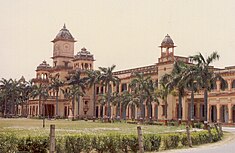N. Ravishankar
N. Ravishankar | |
|---|---|
| Born | 12 February 1970 India |
| Nationality | Indian |
| Alma mater | |
| Known for | Studies on Nanostructured materials |
| Spouse | Vidya Ravishankar |
| Children | Snehasri Ravishankar |
| Awards |
|
| Scientific career | |
| Fields | |
| Institutions | |
| Doctoral advisor | Kamanio Chattopadhyay |
Ravishankar Narayanan (born 1970) is an Indian materials engineer and a professor at the Materials Research Centre of the Indian Institute of Science.[1] He is known for his studies on Nanostructured Materials[2] and is an elected fellow of the Indian Academy of Sciences.[3] The Council of Scientific and Industrial Research, the apex agency of the Government of India for scientific research, awarded him the Shanti Swarup Bhatnagar Prize for Science and Technology, one of the highest Indian science awards for his contributions to Engineering Sciences in 2012.[4]
Biography
[edit]
N. Ravishankar, born on 12 February 1970, did his graduate studies in metallurgical engineering at the Indian Institute of Technology, Varanasi from where he earned a BTech in 1991.[5] Subsequently, he shifted his base to Bengaluru to continue his studies at the Indian Institute of Science (IISc) and earned his master's degree (MSc) in 1993 and followed it up with a doctoral degree (PhD) in 1998. During this period, he did research at the Toyohashi University of Technology as an exchange program scholar in 1996. His postdoctoral studies were at the laboratory of C. Barry Carter of the University of Minnesota from 1998 to 2002. On his return to India, he joined the IISc as a member of faculty at the Materials Research Centre (MRC). At the MRC, he serves as a professor and heads the Functional Inorganic Nanostructures Laboratory.[6]
Legacy
[edit]Ravishankar's research has been focused on the bottom-up paradigm for the synthesis and assembly of nanostructures.[7] He is known to have done extensive work on the template free synthesis of nanowires and shape selection of low-dimensional nanostructured metals which has applications in the development of diagnostic and sensing devices.[2][8] He led a team of scientists who developed, for the first time, ultrathin gold nanowires, with a diameter less than 2 nanometres and high angle boundaries, for use as reaction catalysts for cells.[9] They have also developed a solvothermal process integrating synthesis and assembly. He has documented his researches by way of several articles;[10] Google Scholar and ResearchGate, online article repositories of scientific articles, have listed many of them.[11][12] He is a member of the Solar Energy Research Institute for India and the United States (SERIIUS), an Indo-US joint initiative for the development of solar energy technologies.[13] He has also been a member of the Advisory Committee of the International Conference on Metals and Materials Research, organized by the Indian Institute of Metals, in association with a number of science organizations, in June 2016.[14] He has delivered several keynote or invited lectures[15][16] including those at the workshop on Advanced Tools for Nanoscopic Materials Characterization (2015),[17] and Nanodays 2015.[18]
Awards and honors
[edit]Ravishankar was selected for the Swarnajayanthi Fellowship of the Department of Science and Technology for the year 2009–10.[19] He received the MRSI Medal of the Materials Research Society of India in 2011[20] and the Council of Scientific and Industrial Research awarded him the Shanti Swarup Bhatnagar Prize, one of the highest Indian science awards in 2012.[21] The Indian Academy of Sciences elected him as their fellow in 2015.[22]
See also
[edit]References
[edit]- ^ "Bhatnagar prize for three Bangalore scientists". The Hindu. 27 September 2012.
- ^ a b "Brief Profile of the Awardee". Shanti Swarup Bhatnagar Prize. 2017.
- ^ "Fellow profile". Indian Academy of Sciences. 2016.
- ^ "View Bhatnagar Awardees". Shanti Swarup Bhatnagar Prize. 2016. Retrieved 12 November 2016.
- ^ "Faculty profile". Materials Research Centre, IISc. 2017.
- ^ "Functional Inorganic Nanostructures Laboratory". MRC, IISc. 2017.
- ^ "Researches". MRC, IISc. 2017.
- ^ "Session 3A - Inaugural Lecture". Indian Academy of Sciences. 2017.
- ^ "Going for Gold" (PDF). Indian Institute of Science. 2017.
- ^ "Publications". List of publications. CMR, Indian Institute of Science. 2017.
- ^ "On Google Scholar". Google Scholar. 2016.
- ^ "On ResearchGate". 2016.
- ^ "SERIIUS Team". Solar Energy Research Institute for India and the United States. 2017.
- ^ "Advisory Committee". International Conference on Metals and Materials Research. 2017. Archived from the original on 2 February 2017. Retrieved 8 February 2017.
- ^ "List of Invited Speakers" (PDF). IOPB. 2017.
- ^ "Biomaterials for human healthcare" (PDF). Current Science. 2017.
- ^ "Advanced Tools for Nanoscopic Materials Characterization". SN Bose National Centre for Basic Sciences. 2017.
- ^ "Nanodays 2015". SN Bose National Centre for Basic Sciences. 2017.
- ^ "Swarna Jayanthi Fellowship". Department of Science and Technology. 2016.
- ^ "2011 MRSI Medal". Materials Research Society of India. 2017.
- ^ "Engineering Sciences". Council of Scientific and Industrial Research. 2016. Archived from the original on 23 September 2015.
- ^ "IAS fellows from ISC". Indian Institute of Science. 2017.
External links
[edit]- "Shanti Swarup Bhatnagar prize announced". News report. The Hindu - Business Line. 26 September 2012.
- "Prof. N. Ravishankar at the Bangalore India Nano". Bangalore India Nano. 9 December 2013. p. YouTube video.
Further reading
[edit]- N. Ravishankar (2017). "Intriguing Structure and Transport Behaviour of Ultrathin, Single Crystalline Gold Nanowires" (PDF). Presentation. Indian Institute of Science.
Shanti Swarup Bhatnagar Laureates of Karnataka | |
|---|---|
| Biological Sciences | |
| Chemical Sciences |
|
| Earth, Atmosphere, Ocean and Planetary Sciences | |
| Engineering Sciences | |
| Mathematical Sciences | |
| Medical Sciences | |
| Physical Sciences | |
(*)By birth - (#)By ethnicity - (!)By domicile | |
Text is available under the CC BY-SA 4.0 license; additional terms may apply.
Images, videos and audio are available under their respective licenses.
